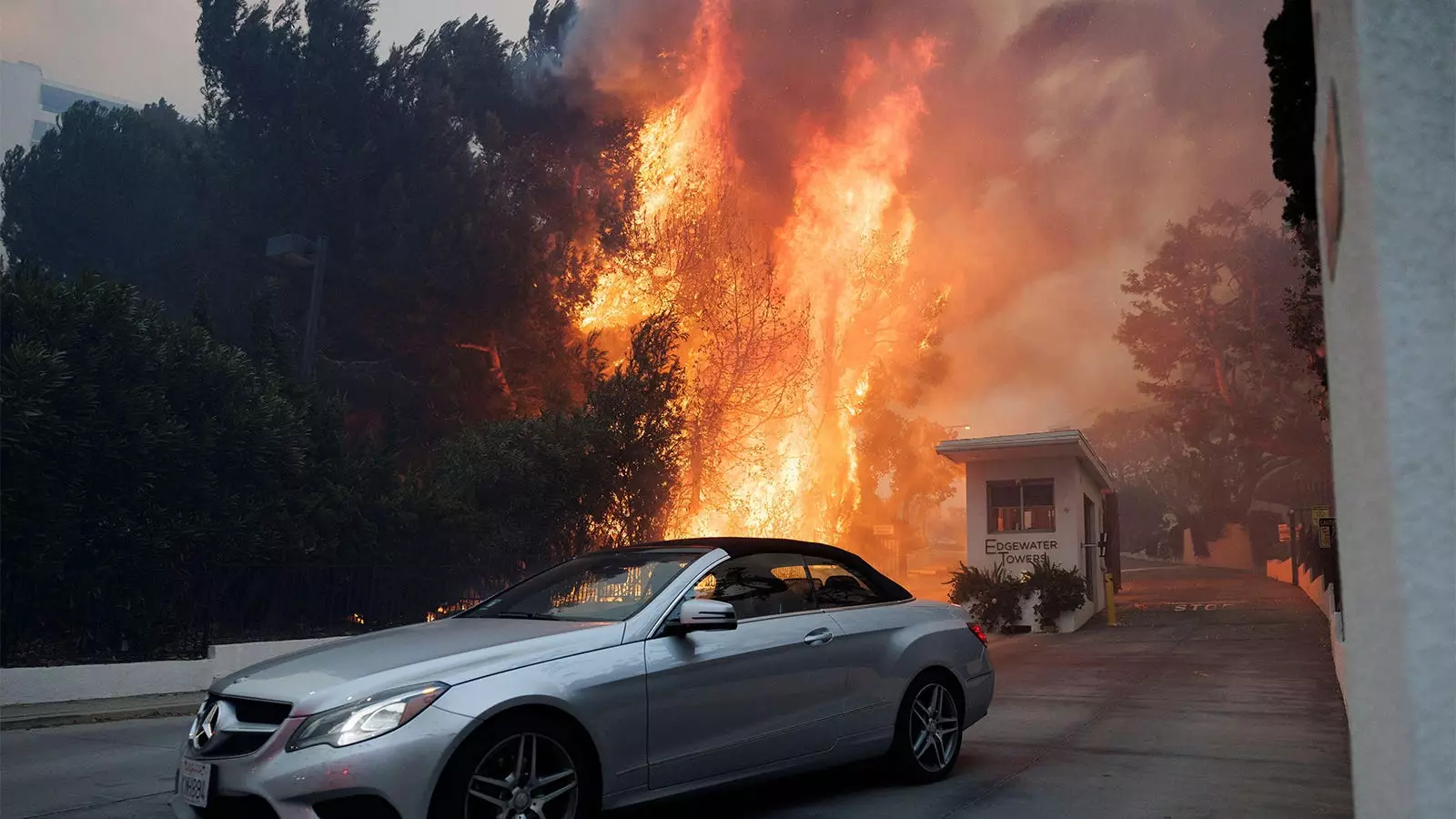As I navigated the haunted expanse of the 405 freeway this past Friday night, I witnessed a surreal sight: a normally bustling thoroughfare lay eerily vacant, veiled by the thick smoke plumes of the Palisades fire. This unsettling view seemed like a twisted painting, evoking the style of Salvador Dalí, with the billowing smoke curling and twisting in the night sky — grotesque reminders of the chaos ignited by nature’s fury, turning our familiar surroundings into a disconcerting tableau. Entering the Sepulveda Pass, the air thickened with particles that swirled into my vehicle, creating a sensory cocoon of ash and despair. Above, the distant machinery of helicopters signaled an uneasy city, adding a pulse of anxiety to the already suffocating environment.
Crossing into the San Fernando Valley on the 101 Freeway, the once-placid hills flickered with ominous hues of red — vibrant reminders of a civilization grappling with an unprecedented wildfire crisis. This environmental disaster extends beyond mere flames; it envelops hundreds of thousands of lives residing at the perilous urban-wildland interface, transforming the cultural fabric of Los Angeles into a nightmarish scenario. Unlike previous infernos, this current crisis releases a toxic brew of chemicals harnessed from man-made structures, poisoning the very air we breathe. Each spark contributes to the dispersion of hazardous particulates, including PM2.5, as well as pollutants from household items, plastics, and construction materials—an invisible threat that imperils both first responders and the broader population.
The implications of these chemical releases are severe and far-reaching. As the community struggles to inhale clean air, an alarming rise in emergency healthcare visits signals the dire effects of inhalation injuries. The long shadow of the immediate danger lies in the chronic health ramifications that will likely reverberate well into the future. The risk of developing various health conditions—most notably cancer—looms large, shadowing both responders who place themselves in harm’s way and inhabitants within proximity of the flames, drawing parallels to the aftermath of events like 9/11.
Beyond physical ailments, the psychological scars are deepening. Most troubling is the emotional toll on those who have lost their homes; anxiety and post-traumatic stress disorder (PTSD) are expected outcomes that will unfurl in the wake of this devastation. Young and old alike will struggle to navigate their shattered realities; the specter of trauma will forever change the landscapes of their lives.
As a professional devoted to understanding the intricate relationship between our environment and health, the current wildfire crisis exemplifies the urgent need for robust systems that address these complex challenges. Occupational and environmental medicine specialists have unique training that equips them to comprehend and respond effectively to natural disasters of this scale. Drawing from experiences such as the response to 9/11 and the COVID-19 pandemic, these medical experts can orchestrate preventive measures to shield our communities from the fallout of fires.
Moving forward, we must amplify our efforts to create innovative, real-time environmental monitoring systems. The integration of data on air quality, pollutant levels, and healthcare access is crucial to empower citizens with critical life-saving information. Prioritizing readiness in the face of these disasters entails forging partnerships across realms, including technology, to innovate environmental monitoring tools that serve communities at risk.
A Plea for Investment in Public Health Infrastructure
However, the road ahead is riddled with challenges; a grave shortage of occupational and environmental medicine physicians persists, exacerbated by the closure of residency programs due to underinvestment. As of 2020, only 25 accredited programs remained in the United States, with many others shuttered in recent years. The implications are profound: the scarcity of expertise stymies our ability to implement resilient strategies to stave off future crises.
The climate challenges of today signify not just local predicaments but are indicative of a global shift that requires a united front. By leveraging data and technology, we can devise a comprehensive approach to urban planning that prioritizes health and sustainability. To emerge from the ashes of this crisis, Los Angeles must position itself as a beacon of hope—a model for other cities grappling with similar environmental calamities.
Charting a Future of Resilience
Our vision for a resilient future must be steeped in innovation, fueled by the principles of occupational and environmental medicine. From developing personalized health guidance systems to implementing preventive protocols that safeguard against exposure, the path forward is illuminated by our commitment to adaptation and progress. Amidst the smoky skies, the clarity of our purpose rings loud: to fortify not just our cities but also our very existence.
As we stare down these monumental challenges, it’s paramount that we remember the power of human determination and ingenuity in the face of environmental adversity. How we choose to confront this crisis will not only define the fabric of Los Angeles but will echo in communities around the world. The time for action is now. Together, let us pave the way for a healthier, more resilient planet.


Leave a Reply